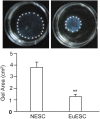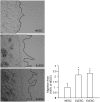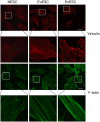Dysregulated cell mechanical properties of endometrial stromal cells from endometriosis patients
- PMID: 24551285
- PMCID: PMC3925909
Dysregulated cell mechanical properties of endometrial stromal cells from endometriosis patients
Abstract
Endometriosis, diagnosed with ectopically implanted endometrial stromal cells (ESC) and epithelial cells to a location outside the uterine cavity, seriously threaten the quality of life and reproductive ability of women, yet the mechanisms and the pathophysiology of the disease remain unclear. Specially, the functional changes of ESC during endometriosis progression need in-depth investigation. In this study, we characterized mechanical properties of normal ESC (NESC) from healthy women and eutopic ESC (EuESC) and ectopic ESC (EcESC) from endometriosis patients. We found the collagen lattice contractile ability of EuESC was significantly stronger than that of NESC, and the cell mobility of EuESC and EcESC was significantly greater than that of NESC. Furthermore, the expression of F-actin and vinculin in NESC, EuESC and EcESC cells progressively increased, and the Rho GTPase activity, of which RhoA exhibited the highest activity, in the three cells gradually increased. Collectively, these results suggest that the mechanical characteristics of NESC, EuESC and EcESC cells exhibited progressive abnormalities. Therefore, the biomechanics of endometrial stromal cells may be a potent target for intervention in patients with endometriosis.
Keywords: Endometriosis; RhoA; cell mechanics; contraction; motility.
Figures




Similar articles
-
Differential expression of microRNA in exosomes derived from endometrial stromal cells of women with endometriosis-associated infertility.Reprod Biomed Online. 2020 Aug;41(2):170-181. doi: 10.1016/j.rbmo.2020.04.010. Epub 2020 May 3. Reprod Biomed Online. 2020. PMID: 32593507
-
Hypoxic conditions affect transcriptome of endometrial stromal cells in endometriosis and promote TGFBI axis.Front Endocrinol (Lausanne). 2024 Dec 18;15:1465393. doi: 10.3389/fendo.2024.1465393. eCollection 2024. Front Endocrinol (Lausanne). 2024. PMID: 39744178 Free PMC article.
-
Elevated phosphatase of regenerating liver 3 (PRL-3) promotes cytoskeleton reorganization, cell migration and invasion in endometrial stromal cells from endometrioma.Hum Reprod. 2016 Apr;31(4):723-33. doi: 10.1093/humrep/dew015. Epub 2016 Feb 13. Hum Reprod. 2016. PMID: 26874360
-
Molecular Mechanisms Underlying the Association between Endometriosis and Ectopic Pregnancy.Int J Mol Sci. 2022 Mar 23;23(7):3490. doi: 10.3390/ijms23073490. Int J Mol Sci. 2022. PMID: 35408850 Free PMC article. Review.
-
Extrapelvic endometriosis: a rare entity or an under diagnosed condition?Diagn Pathol. 2013 Dec 2;8:194. doi: 10.1186/1746-1596-8-194. Diagn Pathol. 2013. PMID: 24294950 Free PMC article. Review.
Cited by
-
Methods for Studying Endometrial Pathology and the Potential of Atomic Force Microscopy in the Research of Endometrium.Cells. 2021 Jan 22;10(2):219. doi: 10.3390/cells10020219. Cells. 2021. PMID: 33499261 Free PMC article. Review.
-
High-grade ovarian cancer secreting effective exosomes in tumor angiogenesis.Int J Clin Exp Pathol. 2015 May 1;8(5):5062-70. eCollection 2015. Int J Clin Exp Pathol. 2015. PMID: 26191200 Free PMC article.
-
Endometriosis and Cytoskeletal Remodeling: The Functional Role of Actin-Binding Proteins.Cells. 2025 Feb 28;14(5):360. doi: 10.3390/cells14050360. Cells. 2025. PMID: 40072086 Free PMC article. Review.
-
Rho GTPases in Gynecologic Cancers: In-Depth Analysis toward the Paradigm Change from Reactive to Predictive, Preventive, and Personalized Medical Approach Benefiting the Patient and Healthcare.Cancers (Basel). 2020 May 20;12(5):1292. doi: 10.3390/cancers12051292. Cancers (Basel). 2020. PMID: 32443784 Free PMC article. Review.
-
Genome-wide genetic analyses highlight mitogen-activated protein kinase (MAPK) signaling in the pathogenesis of endometriosis.Hum Reprod. 2017 Apr 1;32(4):780-793. doi: 10.1093/humrep/dex024. Hum Reprod. 2017. PMID: 28333195 Free PMC article.
References
-
- Coccia ME, Rizzello F, Gianfranco S. Does controlled ovarian hyperstimulation in women with a history of endometriosis influence recurrence rate. J Womens Health (Larchmt) 2010;19:2063–2069. - PubMed
-
- Cunha GR, Cooke PS, Kurita T. Role of stromal-epithelial interactions in hormonal responses. Arch Histol Cytol. 2004;67:417–434. - PubMed
-
- Boyle DP, McCluggage WG. Peritoneal stromal endometriosis: a detailed morphological analysis of a large series of cases of a common and under-recognised form of endometriosis. J Clin Pathol. 2009;62:530–533. - PubMed
-
- Gentilini D, Vigano P, Somigliana E, Vicentini LM, Vignali M, Busacca M, Di Blasio AM. Endometrial stromal cells from women with endometriosis reveal peculiar migratory behavior in response to ovarian steroids. Fertil Steril. 2010;93:706–715. - PubMed
-
- Yuge A, Nasu K, Matsumoto H, Nishida M, Narahara H. Collagen gel contractility is enhanced in human endometriotic stromal cells: a possible mechanism underlying the pathogenesis of endometriosis-associated fibrosis. Hum Reprod. 2007;22:938–944. - PubMed
Publication types
MeSH terms
Substances
LinkOut - more resources
Full Text Sources
Medical
Miscellaneous
